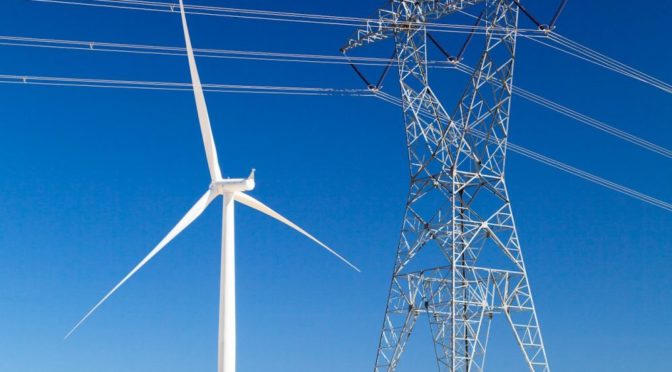Tens of millions of Americans experienced record cold weather at the end of January as Arctic air inundated much of the Midwest and Eastern U.S. However, the power system and electricity markets worked as designed, keeping the lights (and heat) on when customers needed it most. And the value of transmission in keeping the grid reliable and affordable was on full display.
This success demonstrated how renewable energy and transmission increase the power system’s resilience to extreme events. As shown below, wind energy output (orange line) was consistently well above the level planned for by grid operators (grey line) during the period of highest electricity demand (blue line, left axis) on January 30-31 across the Midwest (MISO) and Great Lakes, and Mid-Atlantic regions (PJM). Wind output was even higher on the evening of January 29 when the Midwest experienced very high demand.
This follows wind’s large contributions during last winter’s Bomb Cyclone event, the 2014 Polar Vortex event, and a similar cold snap in Texas in 2011. It is not surprising that wind output was strong, as these events were driven by an intrusion of fast-moving Arctic air into the United States. A secondary factor is that cold air is denser than warm air, proportionally increasing wind turbine output for a given wind speed.
Solar output was also very strong in PJM during the morning peak demand periods on January 30 and 31. Specifically, PJM utility-scale solar output ramped up by around 1,000 megawatts (MW) from 7-10 AM on each of those mornings, helping to meet high electricity demand in those hours. This occurred because the semiconductors that produce electricity in solar photovoltaic panels are significantly more efficient when they are cooled by low temperatures and high wind speeds.
The value of transmission
This event and previous cold snaps also showed the value of transmission for increasing resilience and maintaining access to reliable electricity during extreme weather. On January 30, the cold air moved eastward sooner than expected, decreasing wind energy output in the Midwest but increasing it in the Great Lakes region. This higher wind output helped the Great Lakes and Mid-Atlantic grid operator (PJM) export in excess of 5,000 MW of power westward to the Midwest grid operator (MISO) during its time of peak demand, a reversal of the typical eastward flow of power. This shows the value of wind’s geographic diversity paired with a well-connected grid, creating a more resilient overall system.
Transmission also allowed MISO and PJM to take advantage of the diversity in their electricity demand patterns, in addition to the diversity in their wind output. PJM electricity demand was relatively low on Wednesday morning when MISO experienced its peak demand, while MISO demand was lower by Wednesday evening when PJM experienced its peak demand for the day.
Similarly, during last winter’s Bomb Cyclone, eastern PJM was more affected by extreme cold than western PJM. PJM’s large operating footprint allowed excess power supply from western PJM – including high wind output there and in MISO – to help meet demand in the east, though expanded transmission infrastructure would have provided even larger savings to PJM consumers. Because of transmission congestion, power prices per megawatt hour were consistently higher in eastern PJM (Dominion’s Virginia footprint) than western PJM (ConEd’s Illinois footprint) during the Bomb Cyclone, as shown below. Largely as a result, PJM customers incurred $900 million in transmission congestion costs in the first half of 2018, up from $285 million in the first half of 2017. Expanded transmission infrastructure would have helped alleviate some of these costs.

Onsite fuel is not a silver bullet
This year’s Polar Vortex also demonstrated why it is misguided to focus on generator attributes, like the presence of onsite fuel, when discussing grid resilience. Last week saw large contributions from resources like wind and solar that do not have onsite fuel, just as many resources with onsite fuel experienced outages. PJM has documented that power plants with onsite fuel experienced a variety of challenges during the Polar Vortex, with coal and nuclear generators accounting for nearly half of outages. A similar pattern was also observed during the 2018 Bomb Cyclone, 2014 Polar Vortex, and the 2011 ERCOT event, when generators with onsite fuel experienced widespread outages, mostly due to equipment freezing and breaking in the extreme cold. Instead of specifying characteristics like onsite fuel that are of questionable value for predicting performance, grid operators and others should focus on market-based solutions to obtain needed reliability services from all resources, with payment based on performance.
As studies by the New England and PJM grid operators have shown, wind and solar make important contributions to grid resilience and fuel diversity, particularly during extreme cold weather. For example, during this year’s Polar Vortex, wind output was consistently high in Michigan, helping to compensate for natural gas supply shortages resulting from a fire at a compressor station.
More importantly, these cold snap events show the electricity transmission and distribution systems should be the primary focus of efforts to increase electric resilience, and not power plants. Some customers did lose power in each of the last two winters’ events due to extreme cold causing localized failures on the low-voltage electricity distribution system. As demonstrated above, transmission played a critical role in allowing power to be shared within and between MISO and PJM during both events, and stronger ties could have yielded even greater savings for consumers. These events reinforce the fact that transmission and distribution infrastructure account for more than 99 percent of customer electric outages, with generation and fuel supply failures accounting for a fraction of one percent of power outages.



